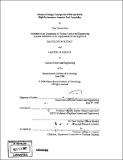| dc.contributor.advisor | Mujid S. Kazimi. | en_US |
| dc.contributor.author | Ellis, Tyler Shawn | en_US |
| dc.contributor.other | Massachusetts Institute of Technology. Dept. of Nuclear Science and Engineering. | en_US |
| dc.date.accessioned | 2008-04-23T14:37:27Z | |
| dc.date.available | 2008-04-23T14:37:27Z | |
| dc.date.copyright | 2006 | en_US |
| dc.date.issued | 2006 | en_US |
| dc.identifier.uri | http://hdl.handle.net/1721.1/41268 | |
| dc.description | Thesis (S.M.)--Massachusetts Institute of Technology, Dept. of Nuclear Science and Engineering, 2006. | en_US |
| dc.description | Includes bibliographical references (p. 105-107). | en_US |
| dc.description.abstract | Sobering electricity supply and demand projections, coupled with the current volatility of energy prices, have underscored the seriousness of the challenges which lay ahead for the utility industry. This research addresses the impending global need for electricity through the development of advanced annular fuel designs with both internal and external cooling which can achieve higher power densities and hence, higher electricity output from the same basic reactor vessel and containment. Therefore the objectives of this project are to determine the optimal geometrical design parameters of an annular fuel assembly for both PWRs and BWRs for the purpose of achieving maximum power density. It is theorized that utility companies can utilize this design through either retrofitting of their existing reactor facilities or incorporation of the fuel design into new plant concepts. For the case of annular fuel for PWRs, a high performance uranium nitride fuel assembly concept capable of achieving a 50% higher power density was successfully developed. It is shown that a 5% enriched UN annular-fuel assembly can operate at 150% power density for about 50 effective-full-power-days more than that of the nominal 17xl7 solid-fuel-pin assembly operating at 100% power density. Furthermore, neutronic simulation times of this assembly was reduced from approximately 2 days per simulation for a Monte Carlo based analysis to approximately 2 minutes for a deterministic based simulation via the development of an appropriate correction factor for the CASMO-4 neutron transport code. It was shown that a 25% increase in U238 number density for the un-poisoned pins and a 35% increase for the 10 weight percent gadolinium nitride poisoned pins produced the optimal plutonium tracking and infinite multiplication factor simulation. | en_US |
| dc.description.abstract | (cont.) Finally, the 13x13 annular fuel assembly was shown to have a smaller reactivity swing over the fuel lifetime. Thus it was concluded that an annular uranium nitride assembly at 150% power density can be designed for PWRs so as not to require enrichments above 5% in order to reach the desirable cycle length of 18 months. For the case of annular fuel for BWRs, thermal hydraulic simulations were carried out for a 9x9 solid fuel reference assembly and three different annular assemblies with 5x5, 6x6 and 7x7 fuel pin geometries. Prior research had utilized the Hench-Gillis CPR correlation for all thermal hydraulic simulations and determined that as much as an 11% uprate for 5x5 annular geometries and an 18% uprate for 6x6 annular geometries might be achievable. However, since Hench-Gillis uses bundle average conditions for its calculations, it was theorized that this treatment was not appropriate for annular fuel. A benchmarking analysis against experimental critical power data for a 9x9 assembly confirmed this is a more appropriate heat balance correlation, the EPRI-1 Reddy Fighetti, which was adopted in our simulation of the critical power using the subchannel analysis code VIPRE. Several different strategies were pursued in order to improve the minimum critical heat flux ratio of the three different annular fuel assemblies including optimization of the fuel pin dimensions, fuel pin gap, and orifice loss coefficients. However it was concluded that annular fuel is not a promising strategy for increasing the power density. This can be due to the fact that the CHFR margin gained from the increase in heat transfer surface area is being lost due to the need for increased flow velocity, which retards the CHF for BWR conditions. This is exacerbated by the inability for the coolant in the inner channels to mix with the surrounding subchannels. | en_US |
| dc.description.statementofresponsibility | by Tyler Shawn Ellis. | en_US |
| dc.format.extent | 183 p. | en_US |
| dc.language.iso | eng | en_US |
| dc.publisher | Massachusetts Institute of Technology | en_US |
| dc.rights | M.I.T. theses are protected by
copyright. They may be viewed from this source for any purpose, but
reproduction or distribution in any format is prohibited without written
permission. See provided URL for inquiries about permission. | en_US |
| dc.rights.uri | http://dspace.mit.edu/handle/1721.1/7582 | en_US |
| dc.subject | Nuclear Science and Engineering. | en_US |
| dc.title | Advanced design concepts for PWR and BWR high-performance annular fuel assemblies | en_US |
| dc.title.alternative | Advanced design concepts for boiling water reactor and pressurized water reactor high-performance annular fuel assemblies | en_US |
| dc.type | Thesis | en_US |
| dc.description.degree | S.M. | en_US |
| dc.contributor.department | Massachusetts Institute of Technology. Department of Nuclear Science and Engineering | |
| dc.identifier.oclc | 213435126 | en_US |
